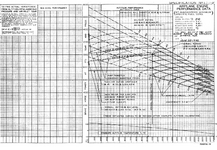Shortround6
Lieutenant General
The British were using the boost settings in the manuals or in the official notes/memorandums.That's a very common issue with the boost ratings during tests, and it certainly cuts both ways - almost all the British tests done at Boscombe Down on a variety of US types, Martlet, Hellcat, Corsair, P-39, P-40 etc. were routuinely done at low boost ratings, for example the Allisons were at military power 40-42" etc (+5 boost)., which severely limited the peak performance. Not that it matters, so long as they are consistently testing all aircraft all the same way, but not all British types were tested with such restrictions. The Hurricane Mk II tests I've seen for example were done at the max allowed boost levels at the time, at 50.5' Hg. (+10 boost), or +12, or +14
This is where some people get the idea that the Hurricane had a higher top speed relative to various US types than it actually did.
The USAAC did not allow combat ratings of the Allison until October 1942.
It doesn't matter how many squadrons or pilots were over boosting the Allisons, if the USAAC and Allison said you shouldn't do it, the the British testers weren't going to do it.
2nd factor is that the US tested different for climb than the British did.
The US would use full throttle, in the case of the Allison 3000rpm, and the max boost listed in the manuals for the first 5 minutes of the climb and then throttle back to 2600rpm and the appropriate boost level for max continuous power level. Planes using radial engines would use the appropriate full throttle rpm and full boost for the first 5 minutes and then throttle back to max continuous power for the rest of the climb.
The British normally did their climb tests at a "climb rating or 30minute rating" which did not exist for American engines. American engines, for much of the war had full power (military) for 5 minutes and then either max continuous (as long as the fuel lasted) or 1 hour, in the early part of the war could see charts with either label, not both. Later it was max continues only the 1 hour time limit disappeared.
The British climb rating changed over time and according to the engine.
Basically when looking at British and American climb charts the British planes (or planes under test) will climb slower than the equivalent American planes for the first 5 minutes and then climb a bit faster after 5 minutes. In no case were the British measuring the "combat climb" unless the test specifically says so.
The British were a bit more practical, if a particular engine seemed to be operating with few, if any problems in service they often, in conjunctions with test results, would allow more boost to be used and then wait a while to see there were any problems, and if their were none they might raise the boost limit again.
For the US the was a test procedure that had to be passed.
To get a WER the engine had to run at the desired power level for at minimum of 5 hours (and usually 7 1/2 hours) worth of 5 minute intervals with cool down periods between every 5 minutes. If the engine suffered a mechanical failure during the test, even at the end, it failed and the engine had to modified and retested or repaired and run at a lower power setting for the required time period.
The fact that officer Schmoe had run his engine for 4 1/2 hours in 10 minute bursts in a number of missions before it threw a rod didn't count to to the USAAC.
This gets a bit weird as the USAAC with the Merin powered P-40s were not OK'ed to use the the same boost settings that the Merlin XX was cleared to use in British planes.
this goes beyond the WER rating. Military power was restricted to 48in/3000rpm (9lbs boost) and max continuous was 44.2in/2650rpm (7lbs) which was the max cruise setting for British engines. the 30 minute climb rating was 48in/2850rpm.
Now the British often tested American planes to British protocols and when climbing they didn't use military power at all and since there was no climb rating to use they dropped down to the max cruise rating for the climb. This basically means that American planes in British tests look they sucked but the British tested all of them the same way. As I have said all the British planes were demonstrating a less than combat climb also. Like the Hurricane II would climb for sea level to 35,000ft using 2850 rpm at whatever boost it could manage that was under under 9lbs (at times the boost control would be out of whack and the boost might be a bit higher but 3000rpm was almost never uses in a climb).
You do have to read the descriptions in the test reports as sometimes they were doing a test for a specific purpose, sometimes they wanted to see how long it took to climb using 3000rpm and full boost but it would be noted that it was a special test.

